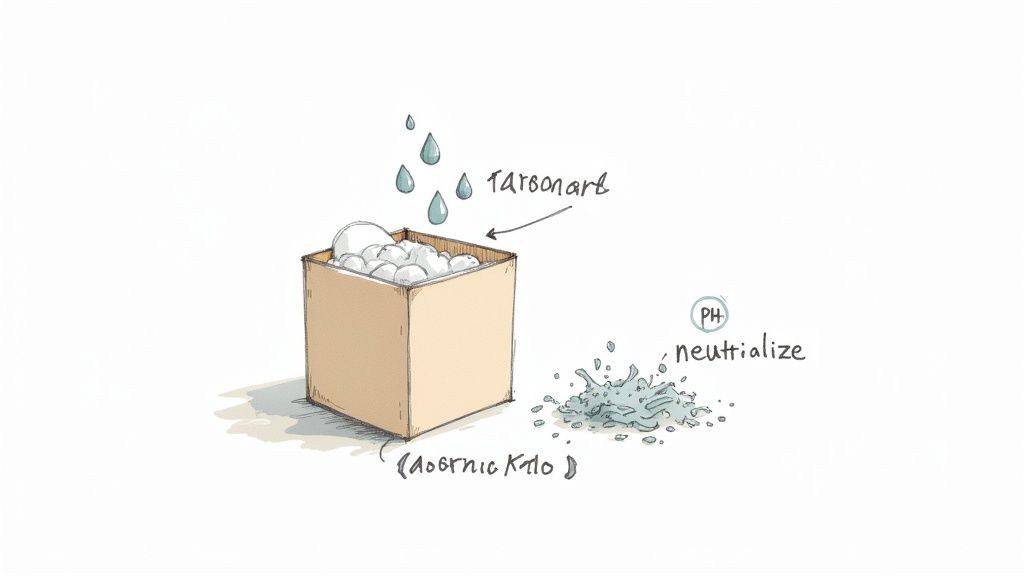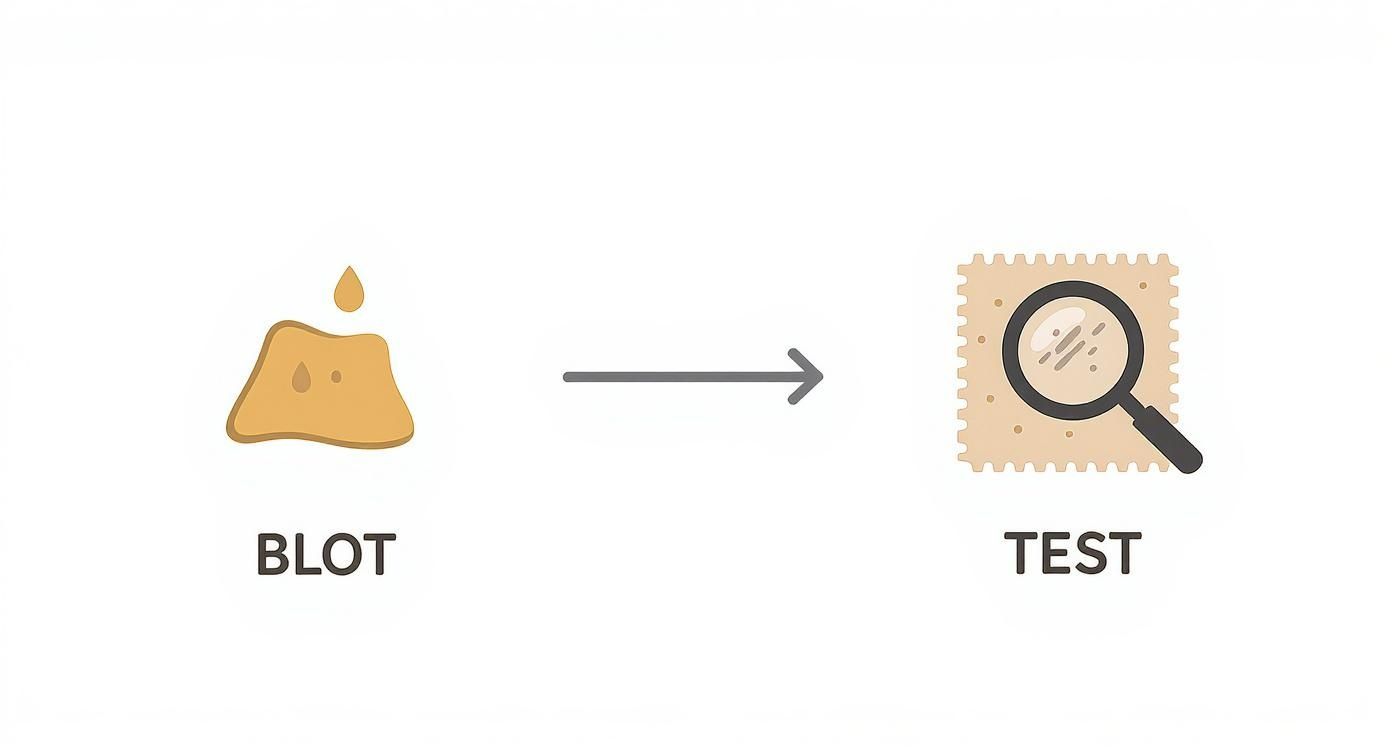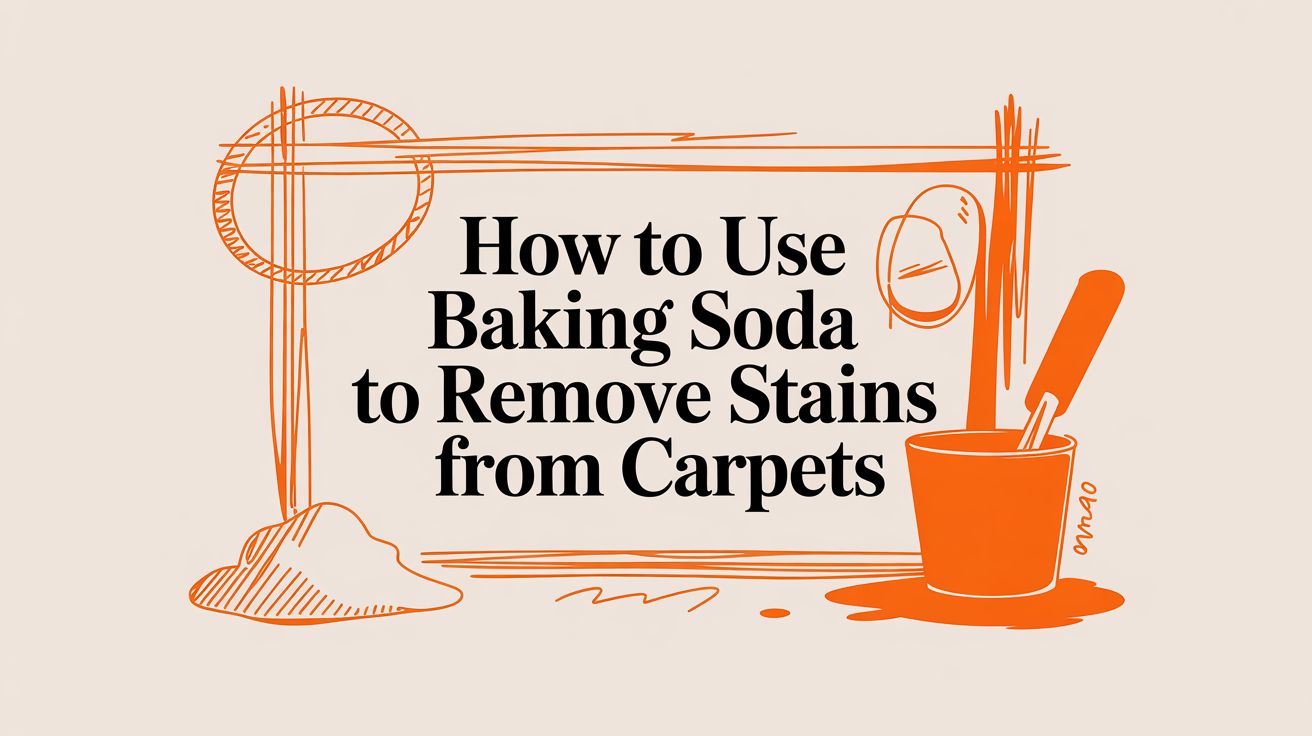Before you grab that bottle of harsh chemical cleaner, take a look in your pantry. That humble box of baking soda is a surprisingly powerful tool for tackling all sorts of carpet messes, and it’s my go-to first line of defense.
Using baking soda to remove stains from carpets is a trick that's not only effective but also incredibly safe and cheap. It works by absorbing spills and neutralizing nasty odors right from the carpet fibers.
Why Baking Soda Is Your Best Bet for Stains

There’s a good reason why baking soda has been a trusted cleaning staple for generations. Its power comes down to some basic chemistry and a fine, absorbent texture that makes it perfect for carpet care.
A Little Bit of Science Goes a Long Way
Baking soda, or sodium bicarbonate if you want to get technical, is a mild alkali. This is the key. Most of the stuff that stains our carpets—think coffee spills, red wine drips, or pet accidents—are acidic.
When you sprinkle baking soda on one of these stains, it gets to work neutralizing those acids. This breaks down the stain's structure and makes it much easier to lift out. At the same time, the fine powder acts like millions of tiny sponges, pulling moisture and smelly particles out from deep in the carpet. It’s a one-two punch that gets rid of the stain and the odor.
For those really stubborn smells that just won't quit, our guide on how to get smells out of your carpet has a few more tricks up its sleeve.
Baking Soda vs Commercial Cleaners: A Quick Look
I get asked all the time if something so simple can really compete with store-bought cleaners. The answer is a resounding yes, and often, it's the better choice.
| Feature | Baking Soda | Commercial Cleaners |
|---|---|---|
| Cost | Pennies per use | Typically $5 – $15 per bottle |
| Safety | Non-toxic, safe for kids & pets | Often contain harsh chemicals (VOCs) |
| Effectiveness | Excellent on fresh, acidic stains | Varies; can be harsh on fibers |
| Eco-Friendly | Natural and biodegradable | Often contains non-biodegradable chemicals |
| Residue | Vacuums up clean, no residue | Can leave a sticky, dirt-attracting residue |
While commercial products have their place, you can see why baking soda is such a fantastic starting point. It's gentle on your carpet and your wallet.
A Safe and Smart Choice for Your Home
Effectiveness aside, baking soda just makes sense for a busy household.
- It's Family and Pet-Friendly. You don't have to worry about toxic fumes or harsh chemicals when your kids and pets are playing on the floor. It's completely non-toxic.
- It’s Good for the Planet. As a natural, biodegradable substance, you can use it without worrying about harming the environment.
- The Savings Are Huge. Switching to natural solutions like baking soda is a smart financial move. Households can easily save 60-70% on cleaning supplies. A baking soda treatment costs less than a dollar, which is a massive difference compared to the $5-$15 you'd spend on a typical spot remover.
Before you even think about grabbing the baking soda, let's talk about what not to do. I’ve seen it a thousand times: someone rushes in, starts scrubbing like crazy, and turns a small spill into a permanent, fuzzy nightmare. A little prep work is the difference between a stain that vanishes and one that moves in for good.
The moment a spill happens—coffee, wine, whatever—your first instinct should be to blot, not rub. Grab a clean, dry towel (microfiber is fantastic for this) and just press down on the fresh, wet stain. The goal here is simple: soak up as much of the liquid as you possibly can. Keep using a fresh, dry part of the towel until it’s barely picking up any moisture.
Don't Make the #1 Carpet Cleaning Mistake
Seriously, resist the urge to scrub. It feels like the right thing to do, but it’s the absolute worst. When you scrub, you’re not just pushing the stain deeper into the carpet fibers; you’re also physically damaging them. That leads to those ugly, frayed spots that never look right again. Blotting is gentle, and it keeps the mess contained instead of spreading it around.
My Go-To Tip: When you're blotting, always work from the outside edge of the stain and move toward the center. This little trick stops the spill from spreading and creating one of those dreaded "stain rings" that are even bigger than the original spot.
Always, Always Do a Patch Test
Look, I know it's tempting to skip this part, but don't. You wouldn't wash a new red shirt with your whites, right? Same principle. Every carpet is different—different fibers, different dyes. You have to make sure your cleaning mix isn't going to bleach or discolor your carpet.
Find a spot no one will ever see to run a quick test. Good places are:
- The carpet inside a closet
- Under a heavy piece of furniture you never move
- On an extra carpet scrap from the installation, if you're lucky enough to have one
Mix up a tiny bit of your baking soda paste and apply it to your hidden spot. Let it dry completely—this might take an hour or more—then vacuum it up. Check for any color changes. If it looks exactly the same, you’re clear to go after that stain. This five-minute check can save you from a massive headache later.
Your Go-To Method for Everyday Spills
Alright, let's get our hands dirty. For those everyday spills—like the morning coffee that decided to jump out of the mug—a simple baking soda paste is going to be your new best friend. This trick is as straightforward as it gets, using stuff you definitely already have in your kitchen.
The main goal here is to whip up a paste that's thick enough to sit on top of the stain without turning your carpet into a soggy mess. I've found a three parts baking soda to one part water ratio works perfectly. Just mix it up in a small bowl until it has a consistency like toothpaste. This makes it a breeze to apply right where you need it.
This visual guide breaks down the prep work you absolutely can't skip before you start.

As you can see, blotting the spill first and testing your cleaning solution on a hidden spot are non-negotiable. Trust me, taking a few seconds to do this can save you from a much bigger headache, like spreading the stain or, even worse, discoloring your carpet.
Application and Dwell Time
Once your paste is mixed, gently spread it over the entire stain. You can use a spoon or a soft spatula to lay down an even layer, making sure every last stained fiber is covered. The key is to not rub it in aggressively. Just let the paste sit on top and do its thing.
Now comes the easy part: you wait. This is where the magic really happens. Let the paste sit on the stain for at least 15-20 minutes. During this time, the baking soda is busy pulling the moisture and odors right out of the spill.
For tougher jobs or those really pungent messes (we're looking at you, pet accidents), you can safely leave it for a few hours or even overnight. If you're dealing with that specific problem, we've got a whole guide on how to remove stubborn pet stains from your carpet.
A key takeaway from my years of experience is that you can't rush this waiting period. Rushing it is the #1 reason this method fails. Giving the baking soda enough time to fully absorb the stain particles is what makes all the difference.
Removing the Paste and Finishing Up
After the paste has had time to work, you'll see it's become dry and crusty. That's a good sign! It means the baking soda has successfully soaked up the liquid from the stain.
Grab a spoon or the edge of a dustpan and gently scrape up the bigger chunks of dried paste. Just be careful not to yank at the carpet fibers. Once you've gotten the bulk of it up, you're ready for the final step.
Vacuum the area thoroughly. I always recommend going over the spot from a few different directions to make sure you get all the fine baking soda particles left behind. You should be left with a carpet that not only looks clean but smells a whole lot fresher, too.
Tackling Tough Stains with Vinegar

Sometimes, that simple baking soda paste just doesn’t cut it. When you’re staring down a nightmare spill—think red wine, a greasy food disaster, or a classic pet accident—it’s time to call for backup. This is where white vinegar really shines, giving your cleaning efforts a serious boost.
The magic happens when you mix baking soda (a base) with white vinegar (an acid). You’ll get that classic fizzing reaction that reminds you of a grade school science project. This isn't just for show; that bubbling action is your secret weapon. The fizz physically gets to work, agitating and loosening the grime that’s trapped deep in your carpet fibers, pushing it all to the surface so you can finally get rid of it.
Creating the Fizzing Solution
Getting this to work is refreshingly simple. First, you'll want to sprinkle a generous layer of dry baking soda directly onto the stain. Don't be shy here—you need enough baking soda to remove stains from carpets, so make sure the entire problem area is completely covered.
Next, mix up a solution of equal parts white vinegar and cool water in a spray bottle. Lightly spritz this mix over the baking soda. You’ll immediately see it start to bubble and fizz. Now, just let it do its thing for about 15-20 minutes.
Once the fizzing has died down and the area feels dry to the touch, you can vacuum up the residue. This one-two punch combines the awesome absorbency of baking soda with vinegar’s powerful stain-lifting action, making it a go-to for more challenging messes.
For even more pro tips, check out our full guide on how to remove tough carpet stains.
It’s this same acidic power that makes vinegar a household MVP for other tough jobs, not just carpets. If you’re curious, you can find similar methods for using vinegar to tackle tough stains on surfaces like windows.
Stain Treatment Reference Guide
Different spills often need a slightly different game plan. While the baking soda and vinegar combo is a fantastic all-rounder, some stains respond better to a more tailored approach.
Here’s a quick reference guide I put together to help you get the best results for common household carpet stains.
| Stain Type | Recommended Method | Key Tip |
|---|---|---|
| Red Wine | Baking Soda + Vinegar | Act fast! The key is to blot as much as possible before the baking soda even touches it. |
| Greasy Food | Baking Soda + Vinegar | Add a drop of dish soap to your vinegar spray. It helps break down the oils much faster. |
| Pet Urine | Baking Soda + Vinegar | Let the dry baking soda sit for a few hours first to fully absorb and deodorize before spraying with vinegar. |
| Coffee/Tea | Baking Soda Paste | A simple paste is usually enough, but add vinegar if the stain is old and set-in. |
Think of this table as your cheat sheet. While every stain is a little different, having the right starting point makes all the difference in winning the battle against stubborn spots.
Common Cleaning Mistakes to Avoid
Baking soda is a fantastic, natural cleaner, but I've seen a few simple missteps turn a quick fix into a much bigger headache. Knowing what not to do is just as important as the "how-to" part when you use baking soda to remove stains from carpets.
One of the biggest mistakes people make is using way too much water. It's easy to do. You mix up a paste, and it feels like more water will help it work better. But when you oversaturate the carpet, that moisture seeps right through to the padding underneath. That's a perfect recipe for mold and mildew, and you'll soon be dealing with a musty smell that's much harder to get rid of than the original stain.
Another thing I see all the time? Aggressive scrubbing. It might feel like you're really working the stain out, but you're actually just wrecking your carpet fibers. You can permanently damage the texture, leaving a fuzzy, worn-out patch that looks worse than the stain did. Always, always blot gently. Let the baking soda do the work for you.
Getting the Timing and Removal Just Right
You've got to be careful about leaving the baking soda on for too long, too. While letting it sit is great for pulling out nasty odors, a wet paste that sits for days will cake up and harden into the carpet fibers. Trust me, it becomes a nightmare to vacuum out completely. Stick to the recommended times to avoid creating a new problem.
The most overlooked mistake, hands down, is not vacuuming thoroughly enough when you're done. Any leftover baking soda residue feels gritty underfoot and, worse, acts like a dirt magnet. It'll attract fresh soil and dust, and you'll see that spot reappear over time.
It’s no surprise that baking soda is so popular. It's part of a huge shift toward eco-friendly cleaning that's been growing since the early 2000s. Its mild alkalinity is perfect for neutralizing acidic stains and odors without the harsh chemicals you find in a lot of commercial cleaners. If you’re interested in the business side of this trend, you can find out more about baking soda's market impact.
Your Top Carpet Cleaning Questions Answered
Even with the best instructions, you're bound to have a few questions. I get these all the time, so let's clear up some of the most common ones about using baking soda to tackle carpet stains.
Is Baking Soda Really Safe for All Carpets?
For the most part, yes. If you have a standard synthetic carpet—think nylon or polyester, which are the most common types—baking soda is perfectly safe.
But if you have natural fiber carpets like wool or silk, you need to be a little more careful. The higher alkalinity of baking soda can sometimes react poorly with these delicate fibers. Your best bet is to always do a quick spot test in a hidden area, like inside a closet, just to be safe.
How Long Does the Baking Soda Need to Sit?
This really depends on the stain you're dealing with.
If you’ve just spilled something and the spot is still damp, 15 to 30 minutes is usually plenty of time for the baking soda to do its job and soak up the liquid.
For older, more stubborn stains, or if you're using the vinegar and baking soda paste method, you'll get better results by letting it sit for a few hours. I’ve even seen people leave it overnight for really tough spots. Just be absolutely sure the paste is bone dry before you try to vacuum it up.
Can Baking Soda Actually Get Rid of Old, Set-In Stains?
It definitely can, but you might need to be patient. Baking soda, especially when you give it a boost with some white vinegar, is great at lifting and lightening old stains.
Success often comes down to what caused the stain and how long it's been living in your carpet fibers. Some stains might come out on the first try, while others will require a couple of rounds to fully disappear.
And once your carpets are clean, it's always a smart move to prevent future pet accidents to keep them looking fresh.
If you've tried everything and that stubborn stain just won't budge, sometimes you need to call in a professional. The team at Citrus Carpet Cleaning Buford is always ready to step in. We'll give you a guaranteed "EXACT-imate" so you know the price upfront and leave you with fresh, truly clean carpets without any sticky residue.
Contact us today to see the difference for yourself.

